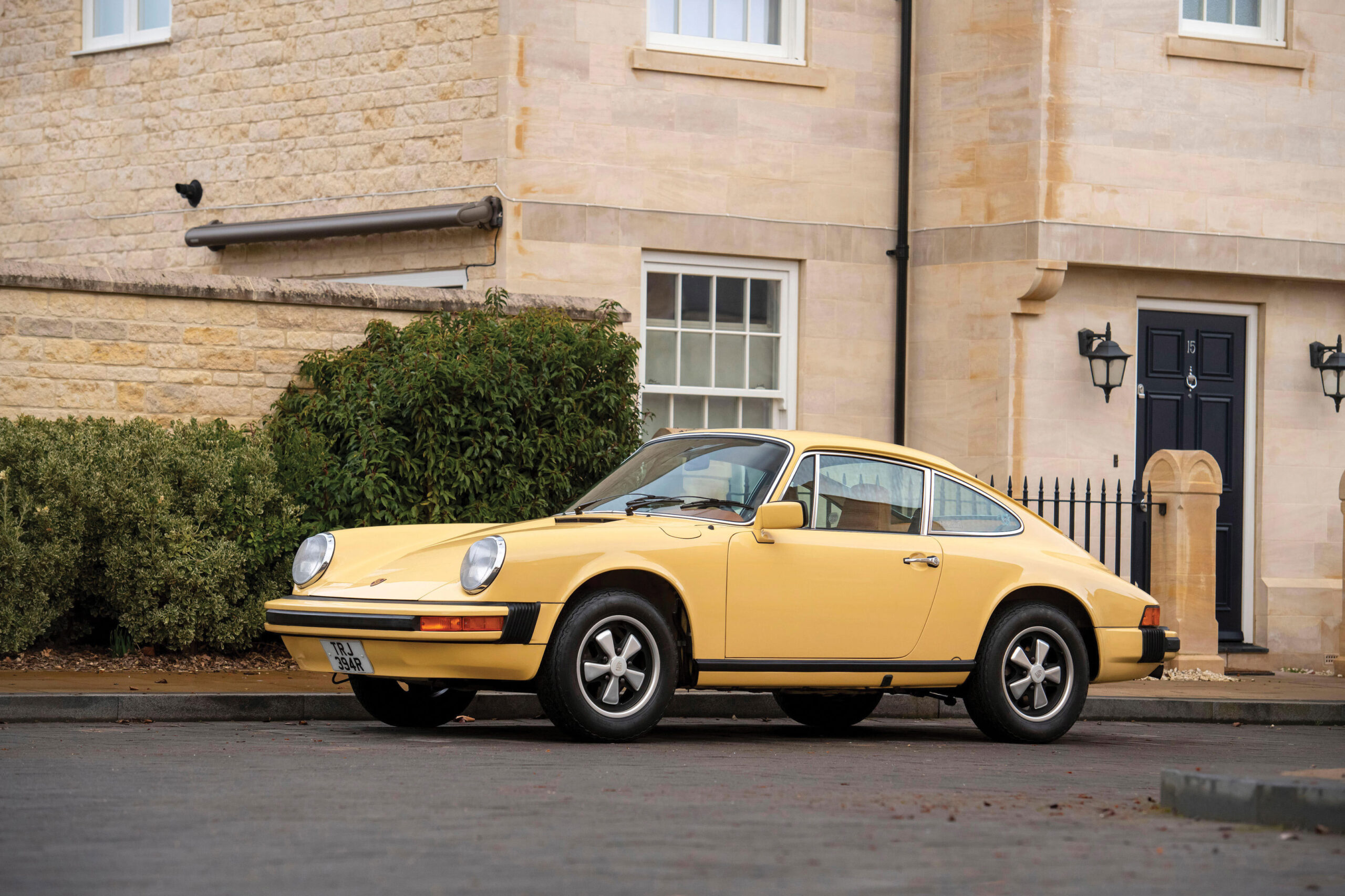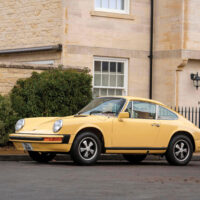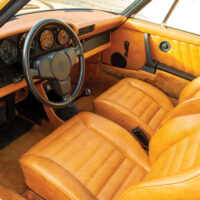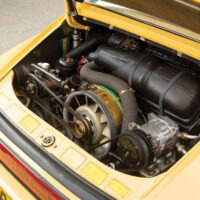Coupled with tolerance for low-lead petrol, vastly superior fuel consumption and increased tank capacity, the new 1974 911 proved superior to its predecessor in every way as a fast, long-distance tourer. By 1977, maximum power output of all non-Carrera models had been standardized at 165 horsepower regardless of the destination market (including California).
This manual-transmission 2.7-liter Porsche 911S coupe was sold new on May 21, 1977, through Carlson Porsche of Palo Alto, CA, and has the exhaust re-circulation anti-smog device fitted to Californian models of this period. Remarkably, the car remained with this same owner until 2013, by which time its odometer displayed just 3,700 miles. Original U.S.-specification headlights and all indicators are included in the sale, and the car also comes with a tailored dust cover. The car even comes with its original date-marked tires!
In 2014, at 3,700 miles, the Porsche was imported into Europe by a well-known European dealer, as evidenced by the accompanying purchase invoice. Sold to a collector in the south of France, the car was imported into the U.K. in January 2018 and sold to our vendor in August of that year by U.K. Porsche experts JMZ Porsche. The car was recommissioned and a comprehensive paint-thickness survey determined that all paint was original and no panels had been resprayed.
There are bills on file for servicing in 2018 totaling over £5,000. The sales invoice and subsequent service work states that the car is a “Totally original, unrestored survivor example.” Interested parties should note, however, there are no mileage records on file. The odometer reading is now 4,300 miles, the condition substantiates the mileage only and the car must be seen to be appreciated. Presented in exceptional condition, this original Porsche 911S must be one of the most original of its type still in existence.
SCM Analysis
Detailing
| Vehicle: | 1977 Porsche 911S 2.7 Coupe |
| Years Produced: | 1974–77 |
| Number Produced: | 17,124 |
| SCM Valuation: | $35,000–$69,000 |
| Tune Up Cost: | $700 |
| Chassis Number Location: | Data plate on passenger’s side inner fender in front compartment |
| Engine Number Location: | Right side of engine case, near fan housing |
| Club Info: | Porsche Club of America |
| Website: | http://www.pca.org |
This car, Lot 94, sold for $100,641 (£80,500) at Bonhams Cars’ Chichester, U.K., auction on April 16, 2023.
Strengthened federal bumper regulations and tighter emission controls threatened to stop U.S. sales of most low-volume cars beginning in 1973. Porsche worked feverishly to comply, but the 1974–77 911s emerged with flaws that harmed Porsche’s reputation.
At first gaze, the new bumpers looked ungainly, but most buyers got used to them. To Porsche’s credit, it used aluminum, so the additional weight was less than you might imagine. The Carrera, introduced in 1974 with flared rear fenders, helped harmonize the bumpers with the rest of the design. Porsche sold lots of Turbos (1976–89) and 911SC/Carreras (1978–89), so the new look was ultimately well accepted.
Porsche tackled the reduction of emissions with 911T models built after January 1, 1973. This required an entirely different Bosch fuel injection, called “continuous injection system” (CIS), as opposed to the mechanical fuel injection (MFI) supplied on many 911 models since 1969. CIS was simple, lower cost, and more emissions-friendly than MFI, but unless a turbocharger was added, it did not provide the high-rpm torque curves of the original MFI 911S models so loved by aficionados. Instead, the CIS system was designed for solid mid-range punch.
Unheavy metal
Can you name another series production car with a magnesium crankcase? Porsche began using this light but expensive material in mid-1968. At the time, it was the largest magnesium casting in production. Leave it to Porsche to go all-out to add lightness, even for street cars. Up through the 2.4-liter engines in 1972–73, these cases worked quite well. The 2.7-liter 1973 Carrera RS also had a magnesium crankcase, which mostly held up. This changed with the 1974–77 2.7-liter 911 road cars, a result of changes in engine operation due to having to meet tougher emission control standards.
Especially in warmer parts of the country, such as Southern California, Texas and Arizona, where 911s were popular, these cars ran hotter than previous models. Beginning in 1975, “thermal reactors” were added to the exhaust system for U.S. cars, which generated even more extra heat. Although hot running temperatures were an easy way to burn excess hydrocarbons, they also accelerated valve-guide wear. Worse, the heat and increased 2.7-liter displacement led to head studs pulling out of the cases.
Head case
Head studs are threaded into the crankcase and run outside of each individual air-cooled cylinder. They secure the heads to the tops of the cylinders. Alloy air-cooled engines expand as they heat, yet the heads must not be loose when cold or excessively tight when the engine is hot. Pulled head studs require engine disassembly and installation of special inserts which enlarge the threaded contact surface between the studs and the case.
The crankcase issue was solved in 1975 for the 930 Turbo by going back to aluminum cases. The 911SC followed (1978–83) as did Carreras (1984–89) and along with better emission controls and cooler-running engines, no more pulled head studs. Still, these long, thin, metal rods can break every 30 years or so, leading some shops to install Dilavar studs, which theoretically expand and contract at a rate similar to the engine. It is much easier to replace a broken stud in an aluminum case rather than one ripped out of an engine made of magnesium.
The good news is that when rebuilt properly, these 2.7-liter engines can be reliable and great fun to drive. The bad news is that like most everything else in the Porsche world, costs for such a rebuild have skyrocketed. Be prepared to pay in excess of $20k.
A reassessment
About a decade ago, prices on 1974-77 models strengthened. This was partly driven by price increases in earlier 911s, but these later versions have more than held their value. Over time, most of the 2.7 engines have been repaired properly, with pulled head studs less of an issue. These were the last “narrow body” 911s which wore 6 x 15” Fuch alloys, the standard after 1968. SCs and Carreras came with 16” wheels and lower profile tires in the U.S., making these cars ride harsher and feel heavier. Enthusiasts who appreciated the nimble feel of the earlier cars realized they had a good alternative in the “midyears.” In a way, these cars were rediscovered.
The 911S of 1974–77 was no longer the top of the line, and after 1975 it became the entry-level offering. Normally aspirated Carreras (1974–75) and Turbo Carreras (1976–77) were the high-dollar models, but the 911 itself had moved upmarket as Porsche sought to develop a whole new range of sports cars.
Garage queen
Our subject car is a marvel of originality. Its suspension looks to sit a bit high; this odd stance may be due to locked shock absorbers arising from lack of use, which is an easy fix. Regardless, I would get the car set to standard European ride height specs so as not to appear to be standing on stilts.
Otherwise, it appears to need nothing. Given its ultra-low miles, it will likely remain that way, with more time spent caring for the car than driving it. In the current market, these sorts of cars always bring strong results, as was the case here. A more-typical 2.7-liter 911S in excellent condition might have earned $30k less. But given this car’s condition, the price paid here was fair to both buyer and seller. ♦
(Introductory description courtesy of Bonhams Cars.)



